I have not been having the best mental health this summer, so for any number of blog posts or ideas for blog posts that I have cooking I am running behind. So let me discuss sharks while it’s still Shark Week.
Funny enough, it’s not exactly “Shark Week Brought to You By Discovery Channel” anymore. Everyone wants a bite out of the action: businesses, even over networks. The National Geographic channel is doing its own “SharkFest” that is going for about a month. But they’re running basically the same kind of specials.
I had the opportunity last weekend while I was visiting family in Mesa to watch a couple episodes of “Why Sharks Attack” or something like that. It was pretty much what I expected: sharks depicted as savage predators, horrifying and gory accounts of attacks on hapless victims, thrill-inducing background music. Misconceptions about sharks are largely built on how documentary producers choose to frame them. If that isn’t a statement about how the media can influence public opinion then nothing is.
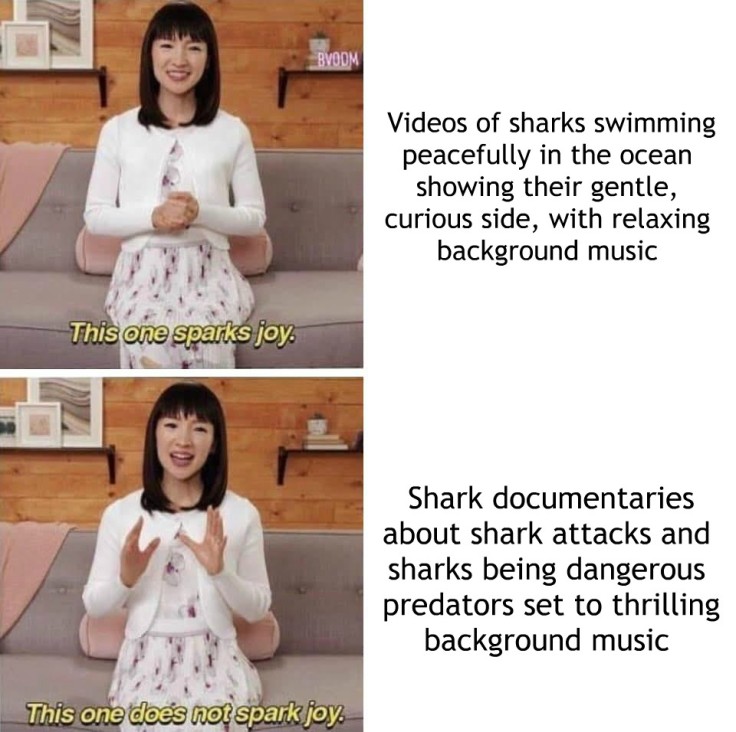
Yet, I still learned things. Did you know, for instance, that internet cables being planted in oceans confuse sharks’ electrical senses? Sharks sensing internet cables close to shore are lured to beaches, and this brings them into contact with humans.
Let’s be serious for a moment: just like wolves, tigers, bears, and other big predators, sharks are wild animals and when they attack it is ugly and painful. We still need to take precautions both to ward away unwanted encounters and to ensure safety when interacting with them.
The reality is that sharks, the so-called apex predators of the oceans, have more to fear from us than we do from them. Commercial and sport fishing have decimated their populations, especially the barbaric Oriental shark fin trade. There are even idiots who drag sharks out of the water just for selfies—shame on you. Shame on all parties. I’m not always enthused about environmental causes but when I am, the survival of my favorite animals is at stake. I see images of slaughtered sharks and fins being dried up for soup and I want to WEEP.
Shark Week: Fearmongering Fiction posing as fact
In the last year, I’ve run wild with my rekindled love for sharks. I have an ever-growing YouTube playlist of the best videos. I am doing lots of shark art, from cute cartoons to full color pencil drawings.
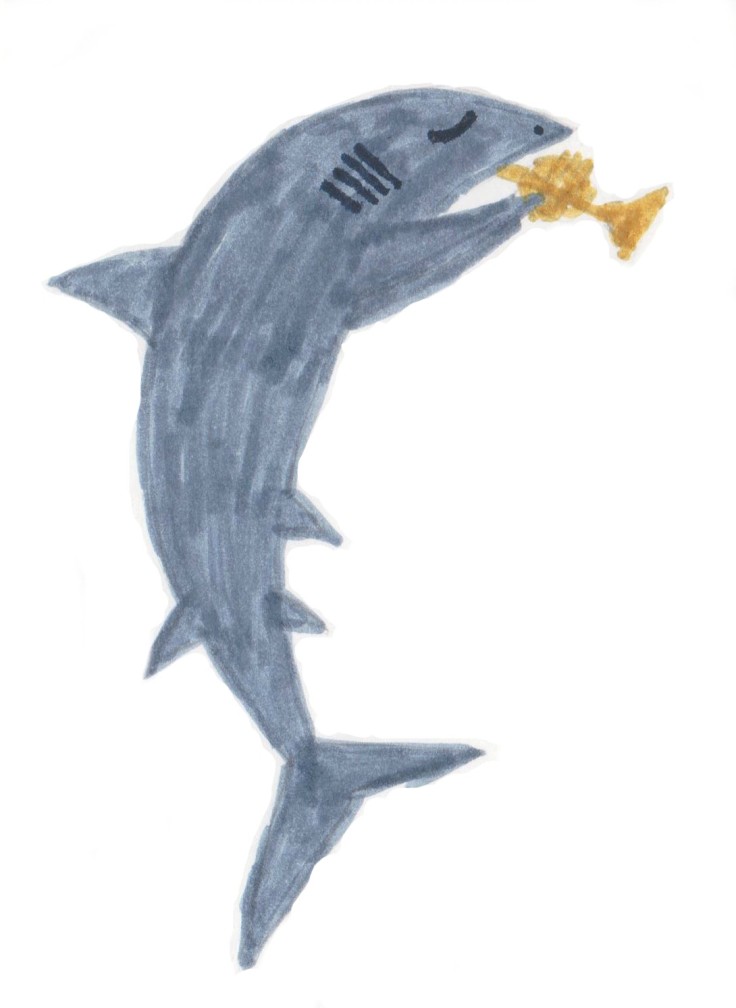
The Baby Shark song is making waves as a popular and annoying children’s song. I’m going to be honest with you, that came out of left field.
On a different note, this last year has seen the rise of Copy Shark.

Leonardo DiSharkio is still the only shark in my life. For the record, you should know that he’s not a real leopard shark.

I’m reluctant to acquire more shark plushes since I already have plenty of stuffed animals, and my family currently lives in a small rental house. But it’s tempting. Especially with the Ikea Blahaj currently the world’s most ridiculous stuffed animal.

Bored Panda: Ikea’s Adorable Plush Shark
I DID make it to the Loveland Living Planet Aquarium last September, right before I left Utah. I went with a friend and we spent the afternoon. There is much to be said for LLPA’s other exhibits, but my favorite spot is the big shark tank. At that point I had already spent several weeks watching shark videos, so it was cool to see some of these species in person.

One of the guides also pointed out to me that there were a pair of epaulette sharks hiding in the rocks in the Touch Tank. She said they were a male and female and the staff had wanted them to breed, but with no success, and they were hiding from each other.

I need to go back because I found out recently that they have a leopard shark that I somehow missed. They also started a meet-and-greet program with their zebra shark (whom I have pet named Ahmed).
So, I’ve watched a lot of YouTube vids, read a lot of informative internet articles, done some art. What have I learned from all that? Lots. Are there things I knew when I went through my shark phase as a kid that I already knew? Yes. But there is so much that I didn’t know before that I am coming across for the first time.
I didn’t know epaulette sharks and zebra sharks existed, for instance. I didn’t know that basking sharks lived off the coasts of Ireland or that ragged-tooth sharks could gulp air to float. I didn’t know that there are lots of other people out there that have the same love for sharks that I do. There are so many big things and little things that I’ve learned and come to appreciate about these funky marine predators. Let me share some with you.
Sharky Senses!
Sharks have it all: great hearing (through a soft spot on top of their heads), stereoscopic smell, ampullae of Lorenzini on their noses for their electrical sense, lateral line for vibrations and movement, and eyesight up to ten times better than our own in clear water—and it’s still functional in murky shallows. They are predators, and they are evolved to be good at what they do.

Shark Eyes
Speaking of eyesight—sharks actually have beautiful eyes. Several species of reef sharks have eyes similar to cats. Even sharks that seem to have solid eyes, like great whites, actually have more depth and shape. Look closely.
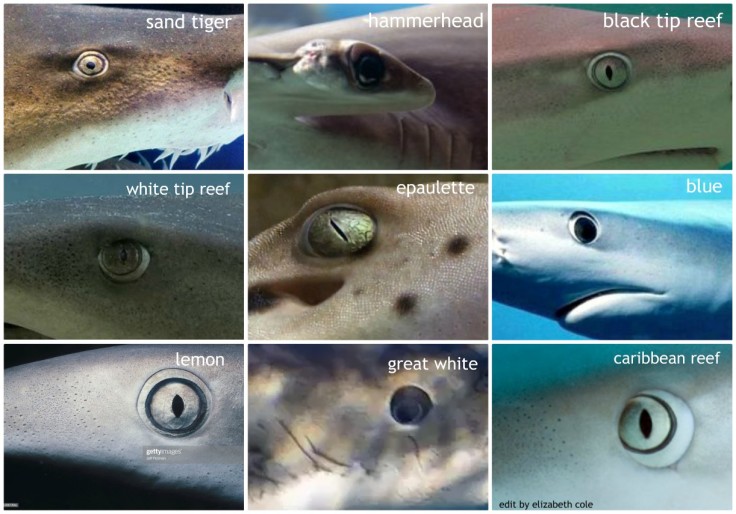
Structurally, sharks eyes’ are similar to ours, with rod cells and cone cells, and cornea, lens, pupil, and an iris. They also have special lids called nictitating membranes that close when the shark is attacking prey.
Bonus: Eye of the Tiger (Shark)

Sharks are Colorful
Colorful? No, really, they are. In general, most of them are varying shades of gray on top with white undersides. This is an adaptation called countershading that makes it harder for prey to see them from above or below.
However, mako sharks and blue sharks have iridescent dark blue coloration that looks like a kind of sunburn. It isn’t solid, it’s iridescent. TL;DR blue sharks are actually blue.
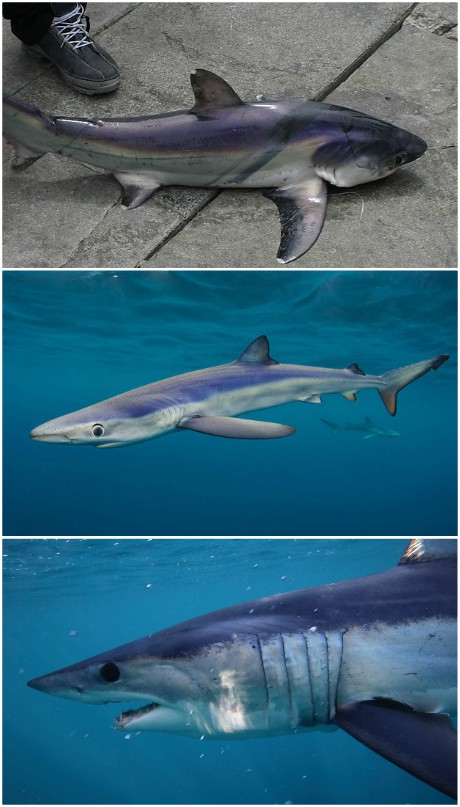
More recently, I learned that Thresher Sharks also have dark purple coloring on their backs.
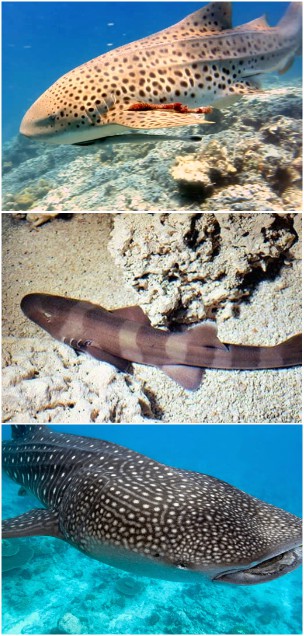
Whale Sharks are more widely known for their green coloration with white spots, and tiger sharks for their stripes. However, there are lots of smaller sharks that have all kinds of stripes and spots.
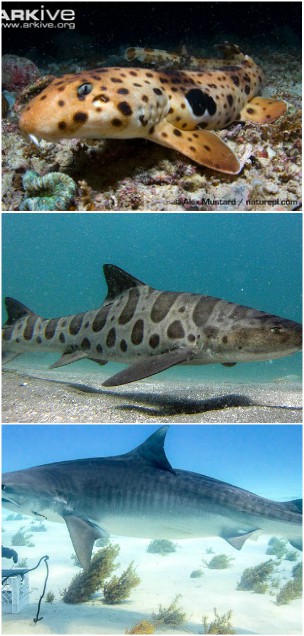
The idea behind this is camouflage, especially blending in with their surroundings for sharks that live on reefs and don’t want to end up on the dinner plate of a bigger fish.
Even the monochromatic sharks, when they are swimming in sunlight, have an array of colors all their own.
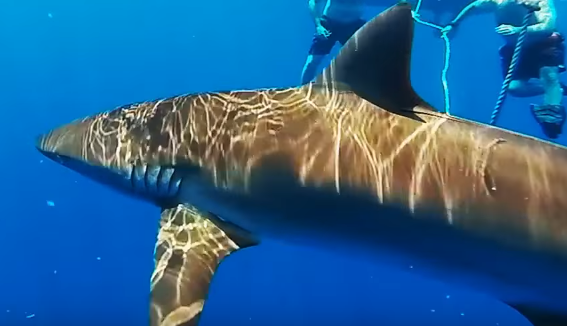
Lemon sharks get their name from the golden-brown color of their backs that is especially visible in sunlight.
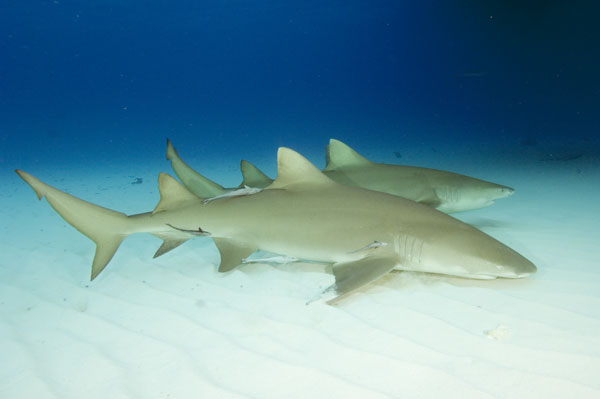
And here’s another fun fact: hammerheads swim near the surface on purpose to TAN and make their countershading darker.

ipFactly: 10 Facts About Hammerheads
EarthTouch News: Oddball Nurse Shark With Spots
Shark Pups are So Stinking Cute
Some sharks hatch from eggs (oviparity). Some are grown inside of their mother’s womb attached to an umbilical cord (viviparity). And some still develop inside of eggs that stay inside of their mother (oviviparity).
I feel kind of sorry for newborn baby sharks. They are thrust into the world suddenly and they are very confused. It takes a few moments to even figure out how to swim right.
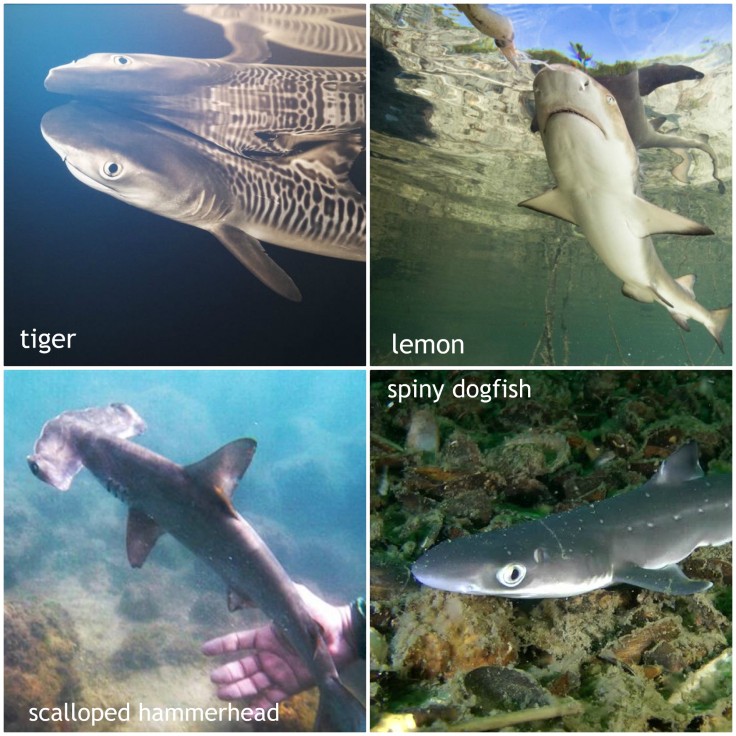
They are not completely helpless, but they are small and vulnerable and easily gobbled up by bigger sharks, including, sadly, grownups of their own kind. Mother sharks have enough maternal instinct to swim to a shallow, protected nursery to give birth, but that is all.
Yes, that’s right, there are nurseries FULL OF CUTE BABY SHARKS in the shallows of some coastal estuaries, mangroves, coves, and bays. Here’s one for scalloped Hammerheads in the Galapagos:
In case you’re wondering, hammerheads’ hammers are really small in the womb, but once they get out the hammers start to grow).
And this is one of the most famous of all shark nurseries, the lemon shark nursery of the mangroves of Bimini, Bahamas:
(Bonus fun fact: lemon sharks are viviparous and have belly buttons)
REAL BABY SHARKS ARE FREAKING ADORABLE AND I WANT TO PROTECT ALL OF THEM.
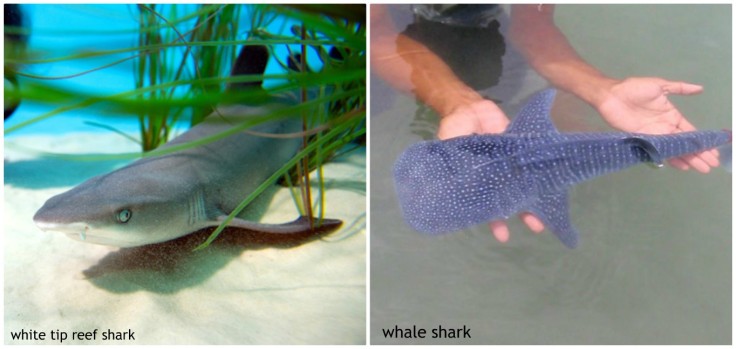
(Yes, including sand tiger/ragged-tooth shark pups, even though they’re basically demons).
Epaulette Sharks Are the Bees’ Knees
Like I said, I didn’t know these little critters existed until last summer. But they are the best new thing I have discovered since comic conventions. These are the sharks I tell my friends about when I want to impress them—and the reaction is usually agreement that they are, in fact, adorable.



Epaulette sharks are small reef sharks that live in the eastern Pacific and Indian oceans. They are also popular pets and touch tank specimens at aquariums. Epaulettes are remarkable because they can hold their breath out of water for up to an hour, and they can walk on their fins. They also have long, snake-like bodies good for swimming between tight spaces, and adorable little round noses.
Here is a clip with Sir David Attenborough describing their superpowers—and wearing crocs.
Precious, am I right or am I right?


Sharks That Sleep in Piles
There is a myth that sharks absolutely must be swimming at all times or they suffocate and die. This is true for a lot of larger, open-ocean species such as hammerheads, silkies, tigers, and great whites (obigate-ram breathers). However, many species that live on the bottom–nurse sharks, wobbegongs, whitetip reef sharks, lemons, and epaulettes mentioned above, can breathe by pumping water through their mouths to their gills (buccal pumping).
Being able to breathe through your mouth can have its perks, especially if you’re a social animal that doesn’t mind proximity to other individuals. Hence, some shark species are known to sleep in piles similar to cats and dogs.
Nurse Sharks in the Maldives

Whitetip reef sharks. I’ll take ten, please!
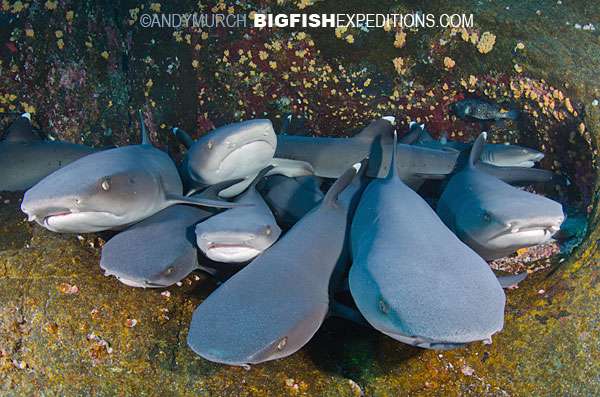

Epaulettes at New England Aquarium

New England Aquarium Blog: Piles of Sharks
Tiger Sharks
I think tiger sharks are officially my favorite species. Individual sharks like Emma and Roxy have ruined me for great whites, sorry. They are big and beautiful and some of them are just so sweet. They have curious personalities, and they’re occasionally cheeky.

Shark Pregnancy
Okay, real talk: the reason overfishing sharks is not a good idea is because some sharks do not reproduce quickly. Many species do not reach sexual maturity until ten or even twenty years of age. Some species that bear their young live carry their offspring for up to a year or even two to three years. I don’t envy sharks for their long gestation periods.
The good news is, pregnant sharks do get baby bumps.

The bad news for this poor bull shark is that she looks like an American football.

White Tip Reef Sharks: Party Animals
White tip reef sharks live off the coasts of tropical nations and islands in the Pacific, including Mexico, Costa Rica, Hawaii, and the Galapagos.

White tip reef sharks rest during the daytime and prefer to do so in quiet nooks and crannies of their reefs—and as mentioned above, in big piles.
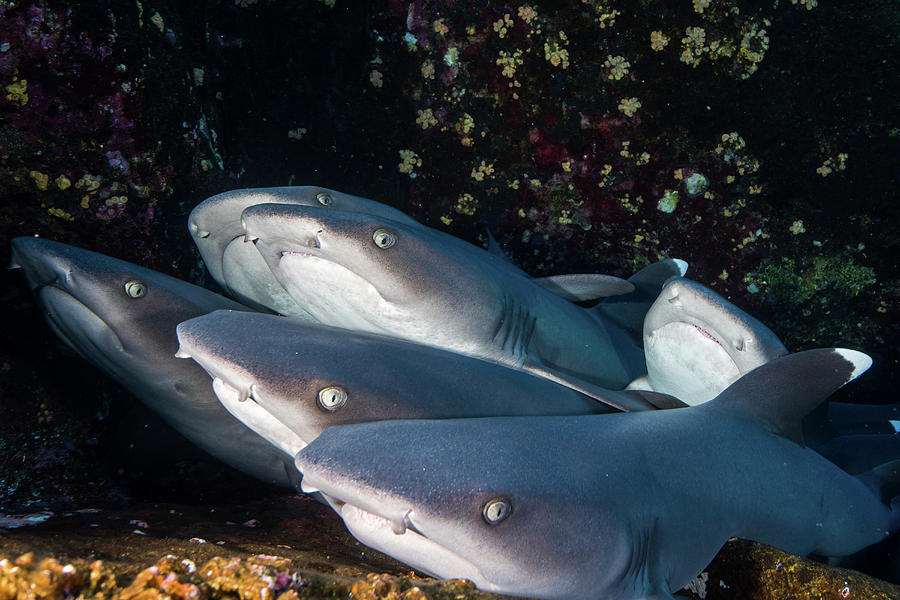
Daytime photos of whitetips look like they’re judging the human photographers.
At nighttime, however, the beat drops and the whitetips have an all-out RAVE PARTY hunt and scour the reefs for food. No fish is safe. No one.

Want to give white tips a fun time? Go night-diving during one of their hunts. The humans’ dive lights make it that much easier.
It’s funny to think about, whitetips being lazy butts by day and partying at night.

Sharks as Virtual Therapy Animals
Watching animal videos is one of my favorite things to do in general, but I like doing so as a way to calm down when I’m having a melt or just a bad day. I find shark videos particularly satisfying for several reasons.
One, sharks live in the ocean, which is blue, and blue is a calming color, and also water is supposed to be relaxing.
Two, sharks are naturally calm and easygoing. They only get aggressive when they’re hungry or provoked. Most of the time they’re serenely swimming through the ocean.
Editing and production, of course, make all the difference between shark clips intended to turn on the adrenaline and the ones that frame sharks as the naturally relaxed creatures they are. The good news is, calming shark footage with soothing background noise is out there.

Video: Nurse Sharks Set To Enya
The Monterey Bay Aquarium has a livestream of its shark tank. They have a big seven-gill shark, at least one dogfish shark, and a handful of leopard sharks that are fun to “spot.” I like watching it just to relax, but it’s a good rainy day strategy to tune in when I’m stressed out. If you want to try it out, keep in mind that they camera is only on 7a.m.-5p.m. Pacific time.
Also if you want to fall asleep real fast, watch videos of sharks resting (sleeping?) on the ocean floor. It works for me.
Brave Wilderness: Don’t Wake the Shark!
Some shark interactions with humans can be heartwarming. There are reef sharks that loooooove nose rubs. Kind of like your needy cat.

The Dodo: Lemon Shark Demands Nose Rubs from Diver
Of course, rescue videos inspire your faith in humanity—but did you know that some sharks even swim up to human divers on purpose to be freed from trash bindings and fishhooks? And after being saved, sharks may stick around long enough to say “thank you,” or even visit the same divers again and again to form lifelong bonds.
Sharks are intelligent creatures, intelligent enough to realize what humans can do with their hands that they can’t for themselves.
To swim with shark, one must become shark. Remain calm. Keep eye contact at all times. No sudden movements. Mind their personal space. Shark diving is about learning to respect the animal and earning their trust. Do not act like prey, act like an equal. That’s what I’ve learned from watching the pros on YouTube.
From time to time, watching videos of people overcoming their fear of sharks on their first shark dive can be cathartic.
The thing is, sharks are my safe place. It’s easier for me to spout off random facts about sharks to my peers than to tell them how my day is going, because it might not be going at all. Entertaining them is a nice bonus.
Not to mention creating art of these beautiful animals is good for the soul. This is a color wheel I made to break in my acrylic paints.
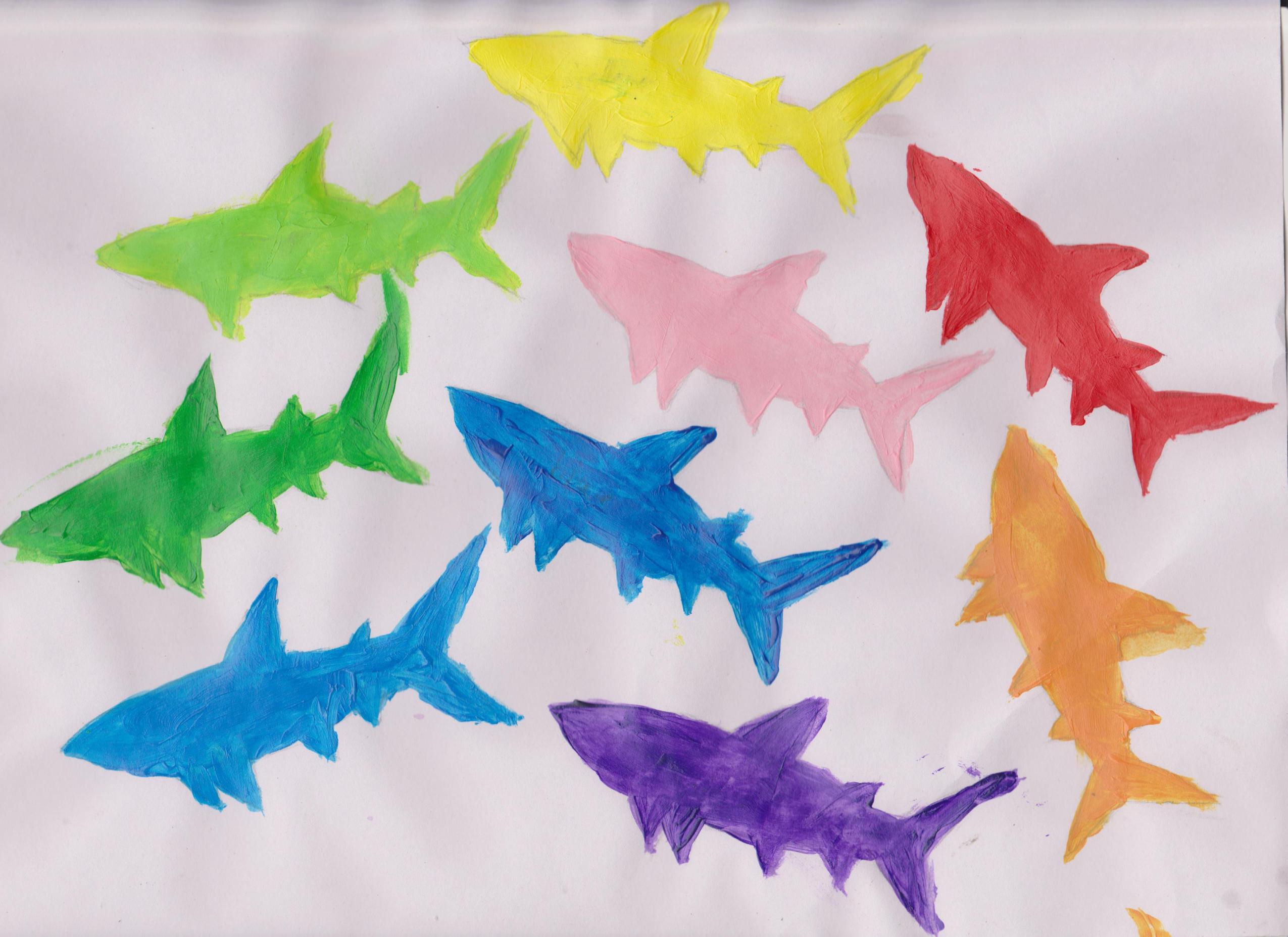
Sharks as Social Animals
Forget the stereotype of the solitary stealthy hunter. There are a few sharks that go it alone in the big blue, but some species of sharks are very social and spend much of their time with other sharks. Studies have shown that these sharks prefer shoals (or shivers) with other sharks of their same age group and gender, much like humans. Some sharks hunt together in packs just like wolves.
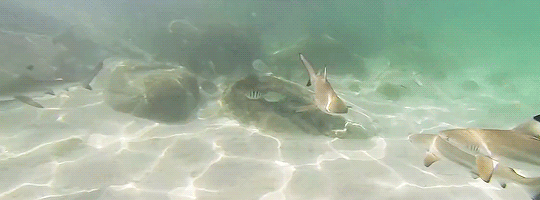
GentleSharks (Tumblr): Black Tip Reef Sharks’ Social Lives
Scalloped hammerheads roam the open oceans in shoals of hundreds; males navigate their way through the shivers to reach the fittest females in a complex mating ritual. Lemon sharks live in large groups for benefits such as avoiding cannibalism by larger sharks and sharing survival strategies. Individuals have even been observed showing preference for other individuals as companions—FRIENDHSHIPS. Do they have cliques? What am I talking about, of course they have cliques!

National Geographic: Lemon Shark Social Networking
Sharks Have Feelings and Like Affection
If it doesn’t blow your mind already that sharks actually have “friends,” what if I told you that sharks can have relationships with humans, too? Sharks come to dive sites like Tiger Beach in the Bahamas to get fish snacks. Some individual sharks come over and over again and the divers get to know them.
Individual sharks are, well, individuals. They have personalities and quirks just like people. Some are more curious than others. Some want more attention than others. Some avoid humans, but others hang out with divers for back massages and pats on the head.

Like I said, sharks love nose rubs from humans. It feels good on their electroreceptors. A few of them care more about getting attention than getting snacks. Some divers argue that these sharks that they’ve built “friendships” are bonded to them by genuine affection, and I believe them.
Sharks can also get scared and angry, and reading shark body language for certain cues is a good way to know whether or not you should back off. Sharks use this body language to communicate with each other and minimize conflict—they would rather not fight each other as much as possible.
And then there’s this zebra shark…
Tonic Immobility
Tonic immobility is a phenomenon that occurs when a shark is either rubbed on the nose or flipped onto its back into a relaxed state. It’s kind of like hypnotizing a bird by rubbing its breast bone. This explains the nose rubs. Reef sharks in a state of tonic immobility can do headstands.
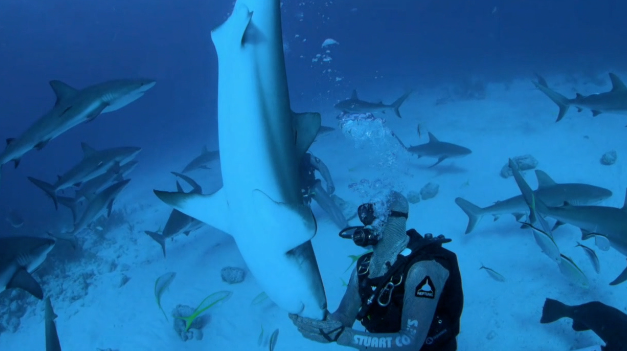
You can also grab tiger sharks on the top and bottom of their head and make them do a barrel roll.
Shark tipping is easier on sharks than cow tipping is on cows, just FYI.
Friends of Sharks
This post is already quite long. I don’t have time to cover everything about sharks that I find jawesome. Perhaps another time.
I live in a landlocked state and I can’t afford to travel often. But I CAN do lots of cool art and memes and spread the word on social media that sharks deserve our love and attention. I’m not alone in that effort. Instagram is a great place to connect with fellow shark lovers and get lots of cool shark photos in your regular feed.
- Jillian Morris-Brake @biminisharkgirl lives in the Bahamas, and she shares lots of photos of lemon sharks on her Instagram.
- Ocean Ramsey is an activist who runs shark dive tours in Hawaii. She got a bachelors’ and a masters’ degree in shark biology and behavior. She could have gone for a PhD. Ocean realized, however, that if she devoted her time to formal research then she wouldn’t be able to save the creatures she loves so much before they were fished and hunted to extinction. Instead, she chooses to make a bigger difference by bringing people up close to sharks and teaching them to understand sharks the way she does. I think that’s beautiful, and it’s a valuable lesson about using our time and talents wisely.

She recently married her fellow diver and shark enthusiast Juan Oliphant. They went to a remote island with a few family members and said their vows in the water with lots of sharks around them. Their wedding photos are INSANE.
- Artists and bloggers like Oh, Dakuwaqa and Sharktopia use their art to spread awareness, and cuteness.

If Winnie-the-Pooh was a shark, he would look like one of Sharktopia’s doodles.
- Jim Abernathy has been running shark diving excursions to Tiger Beach in the Bahamas for years, long enough that he’s befriended certain individual tiger sharks and given them names.
- And of course there’s Jonathan Bird of Jonathan Bird’s Blue World. His actual Emmy-winning series (made with the help of a really awesome team) is all about the ocean and everything in it, with occasional forays to places like the cenotes of Mexico and the astronaut training pool at NASA.
Most importantly, Bird is a HUGE shark advocate and has done some amazing shark dives. He’s a regular at Tiger Beach, but he’s also been diving with Greenland sharks and blue sharks, and he’s done cage diving with great whites of Guadalupe twice. He also has a series of short shark videos called Shark Academy, with highlights on individual species and on topics like reproduction, attacks, senses, and so on. Blue World is on all the socials, so give it a follow.
Someone asked me recently why I like sharks so much. I answered her that it is because they are surprising. In hindsight, that was an accurate answer. Like a lot of things that I have a special interest in, there is more to sharks than meets the eye. They are also misunderstood, and being misunderstood is something I deal with too often. Looking closer, you see that there are a lot of extraordinary things about sharks. They are not mindless savages. They are more than just predatory fish. They are amazing creatures. Let’s protect them, please.
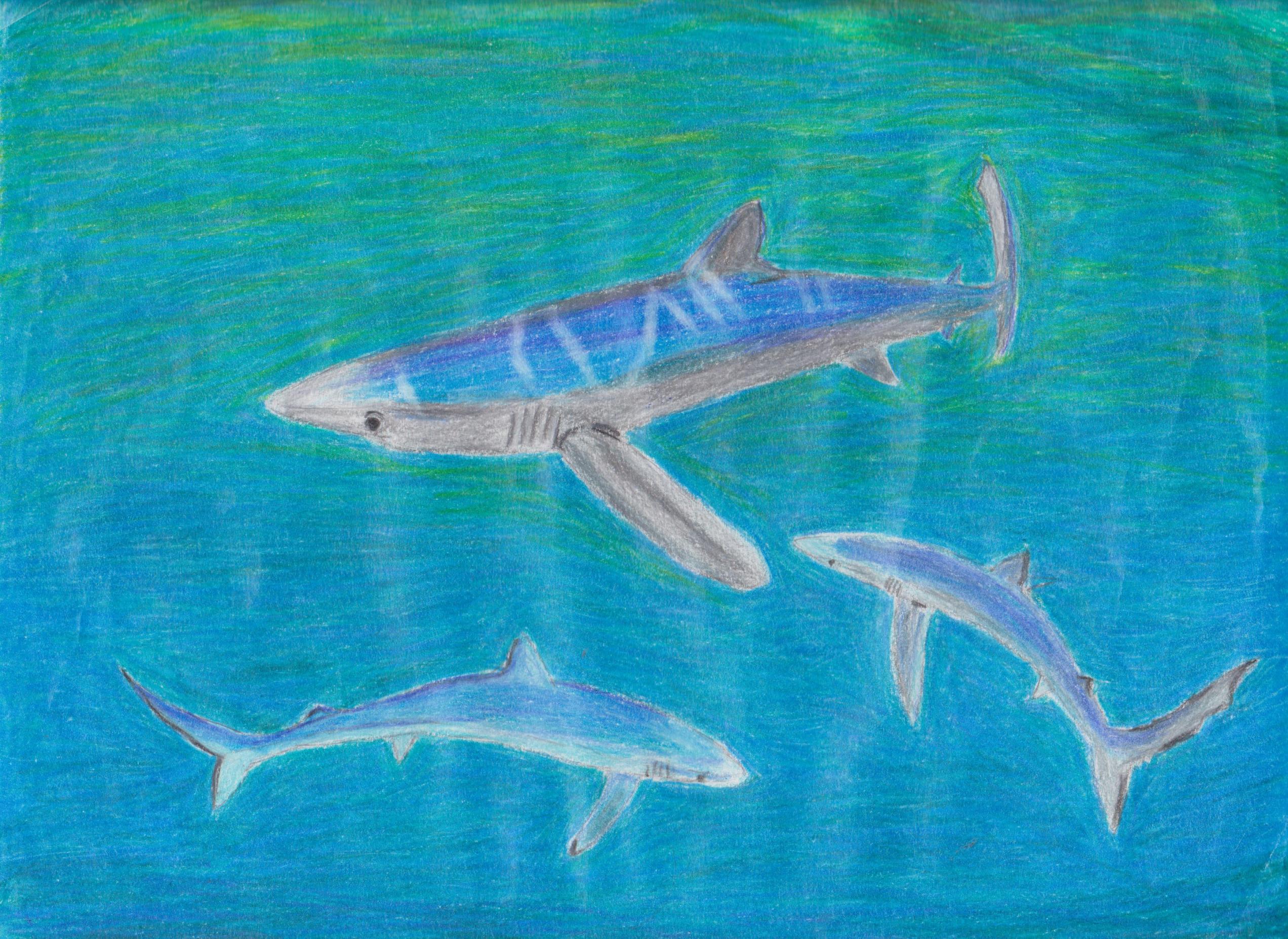

Leave a comment